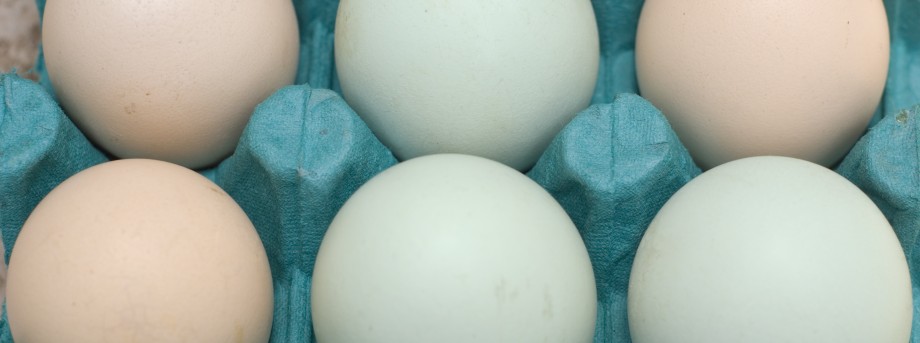The University of Nottingham
 Exchange online
Exchange online
Research Exchange
Unscrambling the genetics of the chicken’s ‘blue’ egg

They are the latest foodie fashion and look set to become big business in the baking aisles of all the major supermarkets – the blue egg produced by some chickens is prettier and some say tastier and cleaner-breaking than the traditional brown one – and now, thanks to scientists from The University of Nottingham, we know what caused the eggs in some breeds to turn this unusual colour.
In a four-year research project just published in the journal, PLOS ONE, the team from the School of Biology, has identified the genetic mutation which first produced the blue egg in native South American chicken, the Mapuche fowl, and their European descendants, Araucana between 200 and 500 years ago. The results could inform future research into agricultural breeding techniques if demand for the blue egg continues to grow.
The scientists used the unique genetic resources conserved by heritage or ‘fancy’ poultry breeders to identify at fine resolution the exact location of the mutation in the genome in blue egg laying chicken. This work was followed by further genomic study which revealed the genetic cause of the blue coloured egg shell – surprisingly – an ancient harmless retrovirus in the domestic chicken.
A retrovirus is a virus that, unlike most cellular organisms, carries its genetic blueprint in the form of ribonucleic acid (RNA). It reproduces itself in a host cell using a special enzyme called ‘reverse transcriptase’ which transcribes RNA into deoxyribonucleic acid (DNA). This makes it possible for genetic material from a retrovirus to become permanently incorporated into the DNA of an infected cell. In this case, the retrovirus’ effect was to trigger an accumulation of a green-blue bile pigment called biliverdin in the eggshell as the egg develops in the hen.
Leading the team, BBSRC doctoral research fellow, David Wragg said: “An unexpected find was the unique integration sites for the retrovirus in South American/European and Asian chickens. It shows the importance of viruses in shaping evolution and diversity of species. It’s quite remarkable – retroviruses are generally considered to integrate at random locations in the genome, and so the chance of a retrovirus integrating at more or less the same location in two chicken populations is extremely low. Moreover, when appearing in the population, the unusual egg coloration must have attracted the attention of the owners, who must be praised for having selected the trait in subsequent breeding.”
Co-researcher, Dr Joram Mwacharo added: “Of course it’s not only some breeds of chicken that produce blue eggs. They are commonly found across species of birds including those that lay blue eggs as well as non-blue eggs within a single population, like the cuckoo and guillemot. It’s therefore entirely possible that retroviruses could be playing a part in the diversity of egg colour and patterning across avian species more generally, but this remains to be studied.”
The work was initiated by Professor Olivier Hanotte whose curiosity about blue eggs was sparked on a trip to Brazil where he met Professor José Antonio Alcalde, co-author of the paper. He said: “This is an important discovery because some of these rarer native breeds of chicken with this unusual egg colour and high quality have become low in number and are in danger of disappearing if not conserved and indeed promoted by agriculture.”
Significantly, the same findings have also been independently discovered and reported this year by a research group in China which has examined local Chinese and North American breeds.
The University of Nottingham research was carried out with the invaluable help of scientists from Universidad Catolica de Chile, Institut National de la Recherche Agronomique in France, International Livestock Research Institute in Kenya, Chinese Academy of Agricultural Sciences in China and the University of Sydney in Australia.
The full article is available online: http://www.plosone.org/article/info%3Adoi%2F10.1371%2Fjournal.pone.0071393
Tags: cells, DNA, food, genetics, School of Biology, School of Life Sciences, virus
Leave a Reply
Other

Top prize for quantum physicist
A University of Nottingham physicist has won a prestigious medal from the Institute of Physics for […]

Zero carbon HOUSE designed and built by students comes home
Design and construct a low cost, zero carbon, family starter home, transport it to Spain, build […]